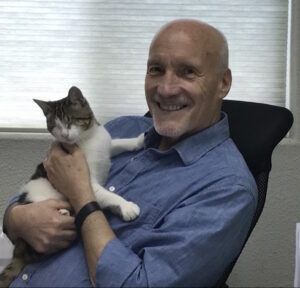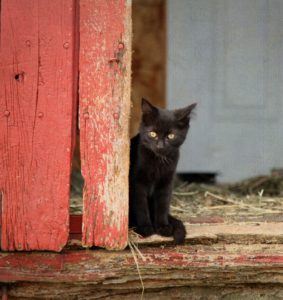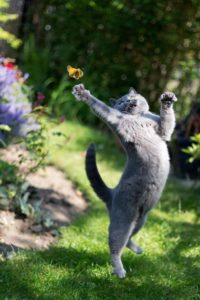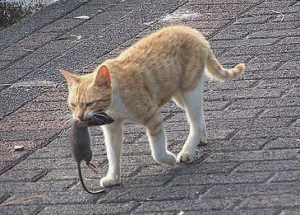 As someone deeply passionate about animal welfare, particularly our feline friends, I’ve encountered numerous cats, each with their own enigmatic personalities and behaviors. Despite their ubiquity in our lives, there are still aspects of cats that often escape our notice or understanding. Let’s explore ten intriguing insights into the mysterious world of cats: Continue reading “10 Things Most People Don’t Know About Cats”
As someone deeply passionate about animal welfare, particularly our feline friends, I’ve encountered numerous cats, each with their own enigmatic personalities and behaviors. Despite their ubiquity in our lives, there are still aspects of cats that often escape our notice or understanding. Let’s explore ten intriguing insights into the mysterious world of cats: Continue reading “10 Things Most People Don’t Know About Cats”
Navigating the Complexities of Animal Welfare: A Perspective by Ed Boks

As an animal welfare advocate with decades of experience in the field, I’ve encountered a diverse array of issues concerning the treatment of animals in our society. From factory farming to regenerative agriculture, compassionate conservation, and domestic pet management, each topic presents its own set of challenges and opportunities. In this article, I’ll delve into the multifaceted landscape of animal welfare, including the pressing issue of domestic pet management, with a particular focus on feral cats. Continue reading “Navigating the Complexities of Animal Welfare: A Perspective by Ed Boks”
Trap/Neuter/Return (TNR): A Humane Solution to Feral Cat Overpopulation

Feral cat overpopulation poses a significant challenge in various regions, including Hawaii, where colonies of free-ranging cats have become a contentious issue. The practice of Trap/Neuter/Return (TNR) emerges as a humane and viable solution to address this problem. Despite protests and criticism, TNR stands out as an effective approach that not only addresses feline overpopulation but also addresses the concerns raised by ecologists and wildlife advocates. Continue reading “Trap/Neuter/Return (TNR): A Humane Solution to Feral Cat Overpopulation”
Operation FELIX: Feral Education and Love Instead of X-termination by Ed Boks
 Insanity, according to Albert Einstein, is “doing the same thing over and over again, expecting different results.” Many communities address their feral cat problem over and over again with two basic methodologies - only to be disappointed by the consequences of their efforts.
Insanity, according to Albert Einstein, is “doing the same thing over and over again, expecting different results.” Many communities address their feral cat problem over and over again with two basic methodologies - only to be disappointed by the consequences of their efforts.
Feral cats are cats who have reverted to a wild state – born from tame cats that owners abandon or allow to run loose. These cats mate with other free-roaming cats, and their offspring, raised without human compassion, are wild, or feral. They grow up and breed with other feral and free-roaming cats and the cat population increases exponentially. Feral cats are considered a public nuisance by some and a public health concern by others. They needn’t be either.
The two methodologies employed by most communities are Do Nothing and Eradication. Decades of applying these methodologies has proven they don’t work – and there are very real biological reasons why.
It is easy to understand why doing nothing has little impact on the problem, but it is not as easy to understand why eradication does not work.
Feral cats typically live in colonies of 6 to 20 cats. When individuals try to catch cats for extermination, this heightens the biological stress of the colony, triggering a survival mechanism that causes the cats to over-breed and over-produce. Consequently, instead of birthing one litter per year with two or three kittens, a stressed female will produce two or three litters with 6 to 9 kittens each.
Even in the unlikely event that a person could catch and remove all the feral cats in a neighborhood, a phenomenon known as “the vacuum effect” would result. The removed colony had kept surrounding colonies at bay, but once removed, all deterrents evaporate and the surrounding cats enter the new territory to over-breed. The vacated neighborhood is quickly overrun with feral cats fighting for mates, caterwauling, and spraying for territory. Extermination only exacerbates the problem and actually produces worse results than doing nothing at all.
However, there is a third methodology that is increasingly practiced in communities across the United States and around the world with amazing results. It is called Trap/Neuter/Return, or TNR.
With TNR, all the feral cats in a neighborhood are trapped, sterilized, and returned to the area where they originated – under the care of a colony manager. The colony manager is a trained volunteer in the neighborhood willing to feed, water, and care for the colony.

TNR prevents the vacuum effect. Altered cats display none of the troubling behaviors of intact cats. Feral cats provide free rodent abatement, a service many neighborhoods unknowingly rely on. Since feral cats only live three to five years, the problem literally solves itself through attrition, provided TNR is implemented community-wide.
TNR also solves public nuisance complaints. There is an adage that says “you can’t herd cats.” In fact, you can herd neutered cats because they tend to hang around the food bowl. No longer having the urge to breed and prey, they follow the food bowl wherever the colony manager takes it. Feral cats can be trained to congregate in areas out of the way of the public.
TNR is a non-lethal, humane and cost-effective solution. Understanding these facts, municipal animal shelters ought to enact a moratorium on accepting feral cats until a comprehensive community-wide feral cat program can be initiated.
TNR empowers citizens to solve this troublesome problem once and for all. Feral cats are trapped, neutered, vaccinated, health-checked by a veterinarian and returned to their neighborhood where their population is stabilized and reduced through attrition.
If you would like more information on TNR or if you need help to develop this program in your community, please contact me.
LA’s Citywide Cat Program (E1907610)
Los Angeles, August 29, 2019 – The City of Los Angeles has prepared a Draft Environmental Impact Report (EIR) to evaluate the potential environmental effects of the proposed Citywide Cat Program (proposed Project) that addresses free-roaming (feral or stray) cats in the City. The City is requesting input on the Draft EIR from public agencies, residents, and other interested project stakeholders.
prepared a Draft Environmental Impact Report (EIR) to evaluate the potential environmental effects of the proposed Citywide Cat Program (proposed Project) that addresses free-roaming (feral or stray) cats in the City. The City is requesting input on the Draft EIR from public agencies, residents, and other interested project stakeholders.
Project Background: In 2006, the City’s Department of Animal Services began to implement a “trap, neuter, return” (TNR) policy and program for free-roaming cats. The City also distributed vouchers to be used for free-roaming cat spay or neuter surgeries, issued cat trapping permits, and otherwise provided support and referrals to community groups that engage in TNR programs. In 2008, the City was sued, and in 2010 the Los Angeles Superior Court issued an Injunction which prohibited the City from further implementing the TNR policy and program without completing an environmental review process in compliance with CEQA (Case No. BS115483). The City prepared a Mitigated Negative Declaration (MND) in 2013, but ultimately decided to modify the proposed Project and prepare an EIR. The scoping process for the EIR began in 2017.
Project Description: Under the proposed Project, the City would: Directly engage in or make available funds for the spay/neuter of free-roaming cats that may be returned to where they were found, relocated to a working cat program, or adopted; Make amendments to the City of Los Angeles Administrative Code (LAAC) to broaden the permitted use of Animal Sterilization Funds and to the City of Los Angeles Municipal Code (LAMC) regarding the definition of a cat kennel; Implement a modified trap, neuter, and return (TNR) program that includes facilitation of trapping, neutering, and returning, TNR-related community education and outreach and collaboration with TNR organizations, and use of incentives to encourage the capture, sterilization, and release of free-roaming cats, including to TNR groups who may return the cats to free-roaming status; Publish and implement program guidelines and ecological conservation measures; and Create a working cat program.
Project Objectives: Broadly stated, the purpose of the proposed Project is to assist in achieving the City’s no kill goal and support the City’s adoption of TNR as the preferred method of addressing the free-roaming cat population in the City. The objectives of the proposed Citywide Cat Program include: Facilitating spaying and neutering of cats in the City; Reducing the relative number of free-roaming cats in the City over time; Facilitating more public and community education on animal-related topics, including free-roaming cats; Training animal services center staff members on cat management programs and engage in collaborative efforts with local rescue groups to help respond to and address free-roaming cat issues; Further implement the City’s no-kill policy by reducing the rate of euthanasia of cats in City animal services centers; and Establishing TNR as the preferred policy to humanely address free-roaming cats.
Environmental Impacts: The analysis contained in the Draft EIR determined that the proposed Project would not result in any significant environmental impacts. No mitigation is required.
Public Review Period: The Draft EIR public review and comment period begins August 29, 2019 and ends on October 28, 2019. The Draft EIR is available online at the Bureau of Engineering website: https://eng.lacity.org/citywide-cat-program-e1907610
Hard copies may also be viewed at the following locations:
- Los Angeles Central Library located at 630 W 5th St, Los Angeles, CA 90071.
- City of LA, Bureau of Engineering, 1149 S. Broadway, 6th Floor, Los Angeles, CA 90015
- North Central Animal Services Center, 3201 Lacy Street, Los Angeles, CA 90031
- South LA Animal Services Center, 1850 West 60th Street, Los Angeles, CA 90047
- West LA Animal Services Center, 11361 West Pico Blvd, Los Angeles, CA 90064
- Harbor Animal Services Center, 957 North Gaffey Street, San Pedro, CA 90731
- East Valley Animal Services Center, 14409 Vanowen Street, Van Nuys, CA 91405
- West Valley Animal Services Center, 20655 Plummer Street, Chatsworth, CA 91311
Public Meeting: A public meeting to receive comments on the Draft EIR will be held on Monday, October 7, 2019 at 6:00 p.m. at the Ramona Hall Community Center, 4580 N Figueroa St, Los Angeles, CA 90065.
Comments: Please send comments on the Draft EIR to:
Comments may also be submitted by e-mail to jan.green.rebstock@lacity.org. Please remember to:
- Send your comments in letter format as an attachment to the email;
- Include a mailing address in the comment letter; and
- Include “CAT PROGRAM” in the subject line.
Following the close of the comment period, the City will consider and prepare responses to the comments received and compile a Final EIR. The Final EIR will be posted online at the Bureau of Engineering website: https://eng.lacity.org/citywide-cat-program-e1907610.
All responses to comments submitted on the DEIR by public agencies will be provided to those agencies at least 10 days prior to certification of the Final EIR. The Board of Animal Services Commissioners and City Council Committee(s) may consider and make recommendations to the Los Angeles City Council regarding the Final EIR and proposed Project. The Los Angeles City Council will make findings regarding the extent and nature of the environmental impacts as described in the Final EIR. The Final EIR will need to be certified by the City prior to making a decision to approve or deny the proposed Project. Public input is encouraged at all public meetings before the City.
More information on the value of TNR programs in your community can be found here:
Analysis of Feral & Stray Cat Solutions
Operation FELIX: Feral Education & Love Instead of X-termination
Time to solve our Feral Cat Problem
Why TNR works and plays an important role in achieving No-Kill
TNR is good public health policy by Ed Boks

During my tenure as executive director of Maricopa County’s Animal Care & Control (1998/2003), I prevailed upon the County Board of Supervisors, with the support of Public Health Director, Dr. Jonathan Weisbuch, to proclaim Trap/Neuter/Return (TNR) the County’s official methodology for humanely reducing feral cat populations.
In addition to reducing the killing in local animal shelters, another benefit to implementing TNR in our cities is that managed feral cat colonies serve as a toxin free rodent abatement program. TNR ends the need for poison to control rodent populations and I think we can all agree that this better for our environment, our wildlife and our pets. Continue reading “TNR is good public health policy by Ed Boks”
Formula to end feral cat killing by Ed Boks

It is commonly understood that any serious initiative to end shelter killing has to focus on ending the “supply side” of the surplus animal equation. The only way to do that is to preemptively spay/neuter those animals most likely to “supply” (give birth to) animals most likely to die in animal shelters.We
The three categories of animals dying in the largest numbers in most shelters throughout the United States are feral cats, pit bulls/pit bull mixes, and Chihuahuas.
There are effective solutions for ending the killing of these populations; and those solutions begin and end with targeted spay/neuter programs. In a previous blog I addressed the need for targeted spay/neuter programs for pit bulls. In this blog, I focus on how to end the killing of feral and stray cats. Continue reading “Formula to end feral cat killing by Ed Boks”
Good news from IRS to volunteers by Ed Boks

One of the best kept secrets to being an animal shelter volunteer is a 2011 U.S. Tax Court ruling. The ruling brought some much-needed clarity to deducting unreimbursed expenses incurred by volunteers helping IRS-recognized charities like your local animal shelter or animal rescue organization.
The case involved Jan Van Dusen, who appeared before a U.S. Tax Court judge and a team of IRS lawyers regarding a tax deduction for taking care of 70 stray cats. Continue reading “Good news from IRS to volunteers by Ed Boks”
State sanctions county, municipal feral cat programs by Ed Boks
 The Yavapai Humane Society (YHS) does not accept feral cats. Taking unadoptable feral cats into an animal shelter is a death sentence and is contrary to the YHS no-kill ethic. Rather than employing the “catch and kill” methodology used by many shelters, YHS champions trap/neuter/return (TNR) as the only viable and humane method for effectively reducing feral cat populations.
The Yavapai Humane Society (YHS) does not accept feral cats. Taking unadoptable feral cats into an animal shelter is a death sentence and is contrary to the YHS no-kill ethic. Rather than employing the “catch and kill” methodology used by many shelters, YHS champions trap/neuter/return (TNR) as the only viable and humane method for effectively reducing feral cat populations.
The Arizona state legislature recently came out in strong agreement with YHS on TNR. Arizona’s governing body overwhelmingly passed SB1260. The new law encourages animal control to return healthy “stray” cats to the vicinity where they were captured after being sterilized; the very definition of TNR.
Coincidentally, perhaps the strongest scientific support for Arizona’s robust endorsement of TNR comes from a 13-month study conducted by the Tasmanian Department of Primary Industries in Hobart, Australia. The study, entitled “Effects of low-level culling of feral cats in open populations” appeared in a recent edition of the journal Wildlife Research, 2015. The findings, trumpeted by the Australian Broadcasting Corporation, Discovery Science, and other media, directly contradict the Australian government, and its environment minister Greg Hunt, who has called for the “effective” eradication of all feral cats by 2023.
Biologist Billie Lazenby, who led the study, says she expected to validate the use of lethal culling (catch and kill) promoted by the Australian government but instead found, to her dismay, that culling markedly increases the numbers of feral cats in an area.
Lazenby and her team of researchers used remote trail cameras to estimate the number of feral cats at two southern Tasmania study sites before and after a 13-month “low-level culling.”
However, Vox Felina blogger Peter Wolf observed, “The effort was anything but low-level. Over the course of 13 months, researchers managed 2,764 trap-nights-an average of seven traps every day of the culling period. Each trapped cat was, after being left in the trap for up to 12 hours or more, ‘euthanized by a single shot to the head from a 0.22 rifle using hollow point ammunition.'”
“Contrary to our prior expectations,” reported Lazenby, the “number of feral cats rose 75 percent at one test site and 211 percent at the other.” Of particular interest, “Cat numbers fell, and were comparable with those in the pre-culling period, when culling ceased.” Suggesting feral cats fill a stable self-regulated ecological niche.
The researchers ultimately concluded the surprising population explosion was the result of “influxes of new [adult] individuals after dominant resident cats were removed.” A phenomenon YHS refers to as the “vacuum effect.” When cats are removed but natural conditions (such as food sources) remain the deterrents of existing territorial cats vanish and neighboring cats quickly invade and overpopulate the newly open territory.
When culling feral cats, Lazenby now says “You may be inadvertently doing more damage than good.”
“What we should focus on when managing feral cats is reducing their impact; and you don’t reduce impact by reducing numbers.” In fact, a growing number of studies conclusively prove lethal culling induces a biological imperative that causes feral cats to overbreed and overproduce to survive. Counter-intuitively, lethal culling directly exacerbates feral cat problems.
Gratefully Arizona has a legislature who understands the science and through SB1260 is directing county and municipal animal control agencies to recognize TNR as the only viable, humane solution to our communities’ vexing feral cat problems.
Arizona is leading the nation through this ground breaking legislation. How wonderful would it be if Yavapai County and local municipalities took the lead by building an effective and humane trap/neuter/return program on this historic foundation?
Putting cats to work helps them and us By Ed Boks
 In a perfect world, all cats would have a loving home, they would be spayed or neutered and they would be kept indoors. Stray cat problems arise because unaltered pet cats are permitted to roam freely outdoors and they either become feral (wild) over time and/or they produce feral offspring.
In a perfect world, all cats would have a loving home, they would be spayed or neutered and they would be kept indoors. Stray cat problems arise because unaltered pet cats are permitted to roam freely outdoors and they either become feral (wild) over time and/or they produce feral offspring.
The only time a cat should ever be allowed outdoors is when it is too feral to keep indoors and then only if it is spayed or neutered so it doesn’t contribute to feral cat overpopulation. However, the responsibility for making sure feral cats are spayed or neutered often unfairly falls to a compassionate person who voluntarily steps up to feed them.
Truth be known, these caregivers and their feral cats deserve our respect and our support; they provide an important service to our developing communities. They help alleviate pressure on our overcrowded shelters; they help keep rodents in check without the use of pest control chemicals that are toxic to the environment and dangerous to pets, wildlife and children; and they help reduce rodent related public health risks, such as the plague, the fatal Leptospirosis, Hantavirus Pulmonary Syndrome, Murine Typhus, Rat Bite Fever, Salmonella enterica serovar Typhimurium, and Eosinophilic Meningitis.
Feral cats have taken the place of the diminishing wild animal populations in preventing an overpopulation of rodents. This is why more and more U.S. communities are joining Denmark, England, Israel and other countries in relying on feral cats to serve as a “green” (environmentally friendly) rat abatement program.
The reason feral cats are so effective is because rodents flee neighborhoods where these cats make their presence known. They actually give off an odor through their paws as they prowl about and once rodents get a whiff of feline, they quickly vacate the premises.
Less grisly than glue traps — and much more effective – feral cats go about their “work” naturally. They prowl, they eat and they sit in the sun; although they prefer to spend much of their time hiding from view.
And the oft heard complaint that feral cats are a public nuisance can be humanely remedied through a formalized feral cat program – because, contrary to conventional wisdom, you can herd cats. Feral cats tend to follow the food bowl. Unobtrusive feeding stations established in out of the way locations ensure feral cat nuisance complaints are greatly reduced if not eliminated altogether.
I encourage municipalities to support feral cat caregivers through a program called Operation FELIX (Feral Education and Love Instead of X-termination). Through Operation FELIX, feral cats are spayed or neutered, vaccinated, micro-chipped and ear-tipped (under anesthesia while the cats are being altered, veterinarians notch an ear tip, the widely recognized sign that a feral cat is altered).
To truly be effective, local municipalities should allocate funding to support Operation FELIX in their respective jurisdictions, as they are typically the recipients of feral cat complaints. Until that happens, YHS depends on donations and grants to help support our community’s volunteer feral cat care givers as they voluntarily provide this valuable community service.
If you want to help support this innovative, non-lethal feral cat program please make a donation to your local shelter and specify “FELIX” on your check.
For more information on Operation FELIX or how to solve feral cat problems in your neighborhood contact me.
If you have a rodent problem in your home or place of business, consider adopting a Working Cat as a humane solution.
In the cold weather, be sure to tap the hood of your car before starting it. Cats often look for warmth under the hood and this simple practice could save a life.
